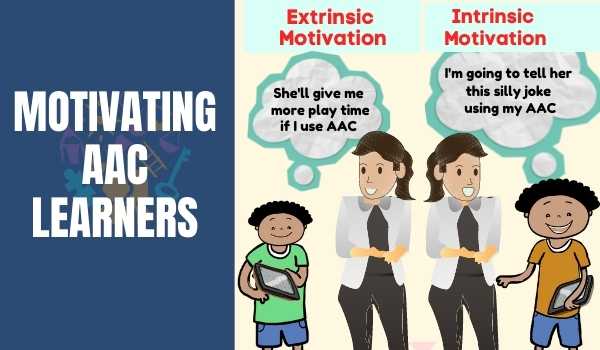Communicative temptations involves setting up the environment, so as to create a need to force them to communicate. A child is much more likely to communicate if he has a reason for doing so!
Setting up communication temptations is easy and there are lots of ways to do so.


Read about ways to motivate AAC users here
Wetherby and Prizant (1989), who formalized the term, were creative in their list of examples. They suggested ideas as given in the list below:
COMMUNICATIVE TEMPTATIONS (from Wetherby & Prizant, 1989)
- Eat a desired food item in front of your child without offering any to him/her.
- Activate a wind-up toy, let it deactivate, and hand it to your child.
- Give your child four blocks to drop in a box, one at a time (or use some other action that your child will repeat, such as stacking the blocks or dropping the blocks on the floor); then immediately give your child a small animal figure to drop in the box.
- Look through a few books (or a magazine) with your child.
- Open a jar of bubbles, blow bubbles, and then close the jar tightly and give the closed jar to your child.
- Initiate a familiar and an unfamiliar social game with your child until he/she expresses pleasure; then stop the game and wait.
- Blow up a balloon and slowly deflate it; then hand the deflated balloon to your child or hold the deflated balloon up to your mouth and wait.
- Hold a food item or toy that your child dislikes out near your child to offer it.
- Place a desired food item or toy in a clear container that your child cannot open while your child is watching; then put the container in front of your child and wait.
- Place your child’s hands in a cold, wet, or sticky substance, such as Jell-O, pudding or paste.
- Roll a ball to your child; after he/she returns the ball three times, immediately roll a different toy.
- Engage your child in putting together a puzzle. After he/she has put in three pieces, offer him/her a piece that does not fit.
- Engage your child in an activity with a substance that can be easily spilled (or dropped, broken, torn, etc.); suddenly spill some of the substance on the table or floor in front of your child and wait.
- Put an object that makes noise in an opaque container and shake the bag; hold up the container and wait.
- Give your child the materials for an activity of interest that necessitates the use of an instrument for completion (e.g. piece of paper to draw on or cut; bowl of pudding or soup); hold the instrument out of his/her reach and wait.
- Engage your child in an activity of interest that necessitates the use of an instrument for completion (e.g. pen, crayon, scissors, stapler, wand for blowing bubbles, spoon); have a third person come over and take the instrument, go sit at a distance while holding the instrument within your child’s sight, and wait.
- Wave and say “bye-bye” to an object upon removing it from the play area. Repeat this for a second and third situation, and do nothing when removing an object from a fourth situation. These four trials should be presented following four consecutive temptations above.
- Hide a stuffed animal under the table. Knock, and then bring out the animal. Have the animal greet your child the first time. Repeat this for a second and third time, and do nothing when bringing out the animal the fourth time. These four trials should also be interspersed with the temptations above when presented.
Types of temptations
1. Display their favourite object / activity without offering it to them
E.g. eating ice-cream in front of them without giving them any. Wait for the child to ask.
2. Don’t complete a fixed routine
E.g. pull the swing back and don’t release it. Wait for the child to ask.
3. Do a routine in the wrong way
E.g. put the right leg socks for the left leg or vice-versa. Wait for the child to ask.
4. Withhold a required item for an activity
E.g. offer ice-cream in a cup without the spoon. Wait for the child to ask.
E.g. hide one of the shoes while going out. Wait for the child to ask.
5. Create an un-favourable / unexpected experience
E.g. Make a sound that the child doesn’t like. Wait for the child to protest.
Examples of using Communicative temptations – Steps:
- Find an activity or an object that your child really enjoys. Look for an activity that is easily stopped and started (e.g., bubbles or a swing) or an object that has multiple parts that you can hand to your child (e.g., crackers that they loves to eat, cars for a car track).
- Create an obstacle – Arrange the environment so that you create an obstacle to getting that object, but so that your child can see the object. For example, put your child’s favorite crackers up on a high shelf. Or, put the cars in see-through container he can’t open.
- Start the activity, have a bit of fun and then stop (put the lid on the bubbles or pull him up in the swing but don’t let him go) or give him one item (e.g., give him one cracker or one car).
- Wait! Many parents forget this part, but it’s an important one. Give your child a chance to communicate first. Ideally, we want him to communicate without us helping him (we want him to initiate the communication), so always wait first. See what he does. Look expectantly at him, like you are waiting for him to do something (which, of course, you are!)
- When the child communicates with you (either verbally or nonverbally):
- Give them what they want and cheer them on–especially if it’s the first time they have used that particular word or two-word phrase, or
- Build on their communication just a bit to help them move into the next stage of speech and language development.
Courtesy: Childtalk



